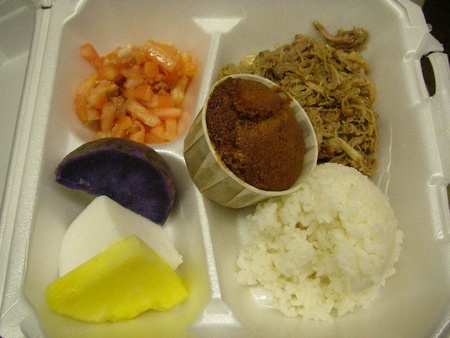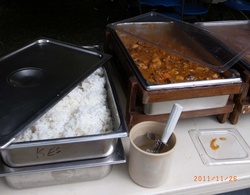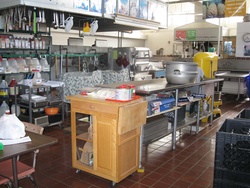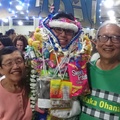This essay series started with the theme of Japanese society in Hawaii, but sometimes I am faced with the question of whether there is such a thing as a "Japanese society" in Hawaii. It is rather exceptional that ethnic communities like Chinatown exist in a visible form. I sometimes feel something like the beginning of Koreatown on the mountain side of the Ala Moana Shopping Center. However, even though there are areas such as Waimanalo and Kapolei with many Hawaiians, and Kalihi and Waipahu with many Filipinos, various ethnicities coexist in these areas. Kapolei has recently undergone large-scale housing development, and Waipahu used to be home to many Japanese people, but the population structure has changed with the decline of the sugar industry. Hawaii Kai, where many Okinawans who run pig farms lived, is now an upscale residential area. In this way, the area is gradually changing, and it is becoming difficult to say, "If you're of that ethnicity, this is the place to be." Inter-ethnic marriages are also spurring this trend.
It is said that Hawaii is a place where "melting pot" and "salad bowl" situations coexist. The situation is very different from that of the American mainland because there is no absolute majority such as the WASP. The immigrants who arrived in Hawaii after a long voyage created a "local" culture that did not exist before, and believed that by sharing it, they would "become" a completely different entity known as "Hawaiian." This can be called a "melting pot" situation.
On the other hand, Hawaii is also a place where many ethnic groups live while maintaining their own identities. Now, as the sixth generation is being born and inter-ethnic marriages are on the rise, the number of people who cannot identify themselves as "what kind of ancestry" is also increasing.
However, the influence of their ancestors remains strong in everyday cultural aspects such as their diet, and their ethnic specific lifestyles are maintained. This unique situation is also reflected in the Hawaiian food culture, for example, the Mixed Plate.
This menu, which can be found at any street-corner lunch stand or restaurant, consists of two servings of rice on a paper plate, surrounded by two or three side dishes such as kalua pig (a traditional Hawaiian dish of salted steamed pork), simmered dishes, chicken cutlet, kimchi, grilled meat, and Portuguese sausage. Dishes from multiple ethnic groups are placed on one plate, forming a single menu. In this case, the plate represents the land of Hawaii, and the rice and side dishes represent each ethnic group. For more information, see the Japanese American National Museum's former traveling exhibition, From Bento to Mixed Plate. This could be said to represent a "salad bowl" type of situation.
So, what is the relationship between "melting pots" and "salad bowls" in Hawaii? When and where do "melting pots" and "salad bowls" appear? A social studies specialist at the Hawaii State Department of Education, who has been a great help to me in my work, said it well.
He suggested that Hawaii is like "stew."
In other words, the ingredients of the stew, such as potatoes, carrots, onions, broccoli, and celery, are the peoples living in Hawaii, and their edges have been rounded off and they melt into the stew soup. The soup is Hawaii's "local" culture, and it clings to our bodies and is shared with each other.
When I heard that, I thought, "I see!" Nearly 15 years have passed since then, and the person who said it has unfortunately passed away, but I continue to feel that way. My friends of different ethnicities share Japanese and Japanese culture with me, and I often don't need to explain anything extra when I talk to them. Not only do they know Japanese culture well, but they often incorporate it into their own lifestyle. I, a Japanese person, often find myself making an effort to actively share their culture. That said, it's only the culture of the Hawaiians I'm often in contact with.
For this reason, rather than speaking of a "Japanese community" in Hawaii, I feel it would be more accurate to say that there is a daily life for Japanese people in Hawaii where multiple cultures coexist and some of them blend together, and that I have been accepted as a part of it.
Last time, I wrote about " Garage Parties ." At the warm parties held in the small garages of M and L's homes, "things related to values such as unchanging Japanese culture in Hawaii and changing Japanese culture are shared and passed on to the next generation." Let's think about examples of culture that is shared and passed on.
One of the reasons why Mr. and Mrs. M. L. are respected by many people is that they are extremely kind. They are not lenient with everyone, but they are also considerate enough to give strict advice at times.
The two of them used to say, "The virtue of Japanese culture that we have inherited is to do everything we can for others." There is a scene that reminds us of this in "Dreams and Living in Hawaii Island" (Magazine House, 1998) by Kenichi Kato and Isseki Nagae. A Japanese tourist is so touched by the kindness of a Japanese Hawaiian that he tries to give the Japanese a watch as a token of appreciation, but ends up greatly offending the Japanese Hawaiian.
Kato Hidetoshi's book "From the Streets of Honolulu" (Chuko Bunko, 1979), which drew me to the charms of Hawaii as a junior high school student, has an entry on "farewell and pick-up ceremonies" in which he discusses the islanders' love of welcoming and departing guests. "The people of Hawaii don't mind such farewells at all. In fact, they won't let you travel secretly. No matter how many times you decline, some people will come. If you don't tell them your flight time, they get angry." (Page 174)
I am treated like their child or their younger brother, and that is exactly what it is. When I visit them a few times a year, they always come to pick me up at the airport. I have breakfast or lunch and then when I return to their house, they lend me their car for the duration of my stay. On the morning I return home, we have breakfast together and they take me to the airport. Then I return the car. This happens every time.
When I was living in Honolulu, I was at the Honolulu airport on my way to a conference held in Las Vegas. As I was wandering around, M-san and L-san suddenly appeared with my favorite food, "Shoyu Chicken". Although I had told them about my flight, M-san handed it to me with a shy smile, saying, "I thought you'd be hungry." I ate the chicken, rice and salad while feeling the cool trade winds blowing through the airport terminal. I didn't have to eat anything until I arrived in Las Vegas, but it was a warm feeling that went beyond just being full.
Let's also look at the negative aspects.
Ms. M and Ms. L were cafeteria managers at neighboring elementary schools.
Just behind L's cafeteria, past the plumeria and mango trees, was a house where an elderly grandmother stayed alone during the day. She would often sit on chairs in the front yard and chat with the neighbors passing by. Since there wasn't enough school lunch, extra was always made. The leftovers were frozen and stored, or shared among friends. I was often given some for dinner. I often delivered some to the grandmother together with L.
The school also treated workers who came to repair the school buildings. At that time, some teachers criticized the school, saying that there was no need to feed the workers. The teachers were white. Naturally, Mr. L was indignant. He said, "They're coming to repair the school, so it's only natural that we should treat them well. There's always going to be leftover food anyway."
Another incident occurred. On Parents Day, the day when parents visit the school, Ms. L was working to provide free school lunches to parents. Like Ms. M's lunches, Ms. L's lunches are also very delicious. Perhaps that's why more parents came to eat than expected, and several parents ran out of chicken nuggets on the menu. Then the group started to complain and make a fuss. They were complaining because there were only two nuggets left instead of three.
What would we Japanese do? Most Japanese would be grateful to receive the school lunch. It's "free food." If something is missing from something that is given for free, we would not complain. If we did, we would be seen by the sun and would be punished. This is Japanese and Japanese culture. When I was little, I was told that I had a "bad mouth" if I complained about the food. The white population in L's elementary school district was increasing. It was white people who complained.
According to Teacher A (see Part 3 of this series, " T-shirts "), the number of residents with an "entitled" mindset has been increasing in recent years, and it's a problem for the school. This refers to people who, in response to kindness, act thoughtlessly, believing that "they will naturally do it for me, that I have a right to have it done for me." (In Japanese, this expression is used in baseball, such as "entitled double base." It does not have a negative meaning.)
Of course, not all white people are the same. I don't intend to talk about stereotypes here. But local cultures are constantly changing as the population changes and the generations of residents change. Comfortable human relationships can also change. In this case, it may be that the flavor of a particular "ingredient" - white people - has become too strong, causing the flavor of the "stew" to lose its balance. Once the balance of flavors is lost, it is really difficult to restore it to its original state.
© 2015 Seiji Kawasaki












